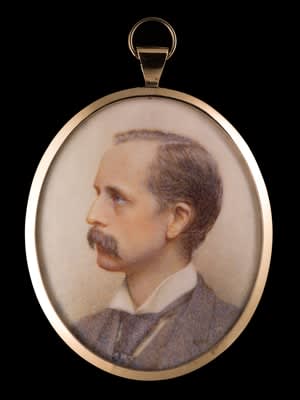
Miss Florence Wilmot
Portrait miniature of James Matthew Barrie (1860- 1937), early 20th century
Watercolour on ivory
Oval, 3 1/8 in. (8 cm)
Philip Mould & Co.
To view all current artworks for sale visit philipmould.com James Matthew Barrie captured the imagination of children and adults alike through his invention of the character Peter Pan, the...
To view all current artworks for sale visit philipmould.com
James Matthew Barrie captured the imagination of children and adults alike through his invention of the character Peter Pan, the ‘Boy Who Wouldn’t Grow Up’. Barrie enjoyed enormous success as a playwright and author at the beginning of the twentieth century but his legacy in the national imagination extends far beyond his lifetime, as he and his young muses, the five Davies boys, have been immortalised several times in both literature and film.
J.M. Barrie, the Scottish author and dramatist, was born in Kirriemuir in 1860. He studied literature at Edinburgh University, before moving to London to pursue a career as an author. He garnered praise for his plays Ibsen’s Ghost (1891) and Walker, London (1892), and saw real success with Quality Street and the Admirable Crichton, in 1901 and 1902, respectively. The first appearance of his most famous literary character, Peter Pan, came in the novel The Little White Bird (or Adventures in Kensington Gardens) which was first serialised in the United States, before being published in a single volume in Britain in 1902. The first performance of Peter Pan, or The Boy Who Wouldn’t Grow Up was in London on 27 December, 1904. It was so successful that it was adapted several times, and published as a novel, Peter and Wendy, by Barrie in 1911.
In 1929, Barrie gave the rights to his most famous play to Great Ormond Street Hospital, who continue to benefit from his generosity to this day. He was also involved in several campaigns from 1909-11, alongside other literary figures including Thomas Hardy, to challenge the Lord Chamberlain’s censorship of the theatre. He was made a Bt. by George V in 1913.
The artist of this miniature, Florence Wilmot (1863-1951) was a pupil at the Birmingham School of Art, and was a pupil of Stanhope Forbes. She later moved to Mickleton, Gloucestershire, where she was an art teacher, and it was here that the portrait miniature of J.M. Barrie was produced. It would go on to be exhibited at the Royal Academy exhibition in 1901, where Wilmot would go on to exhibit several more times.
Wilmot was also an active member of the Royal Miniature Society from 1884-1934.
James Matthew Barrie captured the imagination of children and adults alike through his invention of the character Peter Pan, the ‘Boy Who Wouldn’t Grow Up’. Barrie enjoyed enormous success as a playwright and author at the beginning of the twentieth century but his legacy in the national imagination extends far beyond his lifetime, as he and his young muses, the five Davies boys, have been immortalised several times in both literature and film.
J.M. Barrie, the Scottish author and dramatist, was born in Kirriemuir in 1860. He studied literature at Edinburgh University, before moving to London to pursue a career as an author. He garnered praise for his plays Ibsen’s Ghost (1891) and Walker, London (1892), and saw real success with Quality Street and the Admirable Crichton, in 1901 and 1902, respectively. The first appearance of his most famous literary character, Peter Pan, came in the novel The Little White Bird (or Adventures in Kensington Gardens) which was first serialised in the United States, before being published in a single volume in Britain in 1902. The first performance of Peter Pan, or The Boy Who Wouldn’t Grow Up was in London on 27 December, 1904. It was so successful that it was adapted several times, and published as a novel, Peter and Wendy, by Barrie in 1911.
In 1929, Barrie gave the rights to his most famous play to Great Ormond Street Hospital, who continue to benefit from his generosity to this day. He was also involved in several campaigns from 1909-11, alongside other literary figures including Thomas Hardy, to challenge the Lord Chamberlain’s censorship of the theatre. He was made a Bt. by George V in 1913.
The artist of this miniature, Florence Wilmot (1863-1951) was a pupil at the Birmingham School of Art, and was a pupil of Stanhope Forbes. She later moved to Mickleton, Gloucestershire, where she was an art teacher, and it was here that the portrait miniature of J.M. Barrie was produced. It would go on to be exhibited at the Royal Academy exhibition in 1901, where Wilmot would go on to exhibit several more times.
Wilmot was also an active member of the Royal Miniature Society from 1884-1934.
Be the first to hear about our available artworks
* denotes required fields
We will process the personal data you have supplied in accordance with our privacy policy (available on request). You can unsubscribe or change your preferences at any time by clicking the link in our emails.